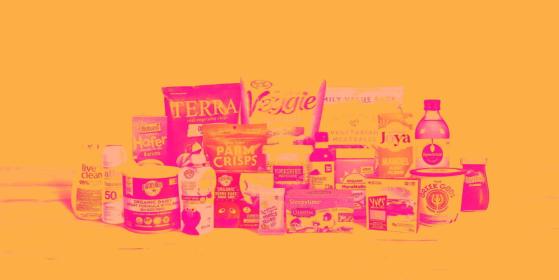Stock Story -
Natural food company Hain Celestial (NASDAQ:HAIN) missed analysts' expectations in Q1 CY2024, with revenue down 3.7% year on year to $438.4 million. It made a non-GAAP profit of $0.13 per share, improving from its profit of $0.08 per share in the same quarter last year.
Is now the time to buy Hain Celestial? Find out by reading the original article on StockStory, it's free.
Hain Celestial (HAIN) Q1 CY2024 Highlights:
- Revenue: $438.4 million vs analyst estimates of $463.4 million (5.4% miss)
- Adjusted EBITDA: $43.8 million vs analyst estimates of $39.2 million (11.7% beat)
- EPS (non-GAAP): $0.13 vs analyst estimates of $0.07 ($0.06 beat)
- Lowered full year guidance for organic sales growth and adjusted EBITDA
- Gross Margin (GAAP): 22.1%, up from 21.4% in the same quarter last year
- Free Cash Flow of $30.24 million, up 104% from the previous quarter
- Organic Revenue was down 3.7% year on year
- Market Capitalization: $598.3 million
Sold in over 75 countries around the world, Hain Celestial (NASDAQ:HAIN) is a natural and organic food company whose products range from snacks to teas to baby food.
Shelf-Stable FoodAs America industrialized and moved away from an agricultural economy, people faced more demands on their time. Packaged foods emerged as a solution offering convenience to the evolving American family, whether it be canned goods or snacks. Today, Americans seek brands that are high in quality, reliable, and reasonably priced. Furthermore, there's a growing emphasis on health-conscious and sustainable food options. Packaged food stocks are considered resilient investments. People always need to eat, so these companies can enjoy consistent demand as long as they stay on top of changing consumer preferences. The industry spans from multinational corporations to smaller specialized firms and is subject to food safety and labeling regulations.
Sales GrowthHain Celestial carries some recognizable brands and products but is a mid-sized consumer staples company. Its size could bring disadvantages compared to larger competitors benefiting from better brand awareness and economies of scale. On the other hand, Hain Celestial can still achieve high growth rates because its revenue base is not yet monstrous.
As you can see below, the company's revenue has declined over the last three years, dropping 4.6% annually. This is among the worst in the consumer staples industry, where demand is typically stable.
This quarter, Hain Celestial missed Wall Street's estimates and reported a rather uninspiring 3.7% year-on-year revenue decline, generating $438.4 million in revenue. Looking ahead, Wall Street expects sales to grow 4.9% over the next 12 months, an acceleration from this quarter.
Cash Is KingAlthough earnings are undoubtedly valuable for assessing company performance, we believe cash is king because you can't use accounting profits to pay the bills.
Hain Celestial's free cash flow came in at $30.24 million in Q1, up 40.1% year on year. This result represents a 6.9% margin.
Over the last eight quarters, Hain Celestial has shown mediocre cash profitability, putting it in a pinch as it gives the company limited opportunities to reinvest, pay down debt, or return capital to shareholders. Its free cash flow margin has averaged 1.9%, subpar for a consumer staples business. However, its margin has averaged year-on-year increases of 6 percentage points over the last 12 months. Continued momentum should improve its cash flow prospects.
Key Takeaways from Hain Celestial's Q1 Results We were impressed by how significantly Hain Celestial blew past analysts' EPS expectations this quarter. On the other hand, its revenue unfortunately missed analysts' expectations and its organic revenue missed Wall Street's estimates. Looking forward, full year guidance for organic sales growth and adjusted EBITDA were lowered. Overall, this was a mediocre quarter for Hain Celestial. The stock is flat after reporting and currently trades at $6.61 per share.
